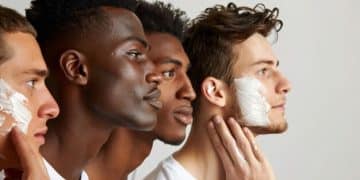Men’s Skincare Routine for Beginners: Visible Results in 30 Days

Achieving noticeable improvements in men’s skin health within 30 days requires a consistent, simplified skincare routine focusing on cleansing, moisturizing, and sun protection, tailored to individual skin types and concerns without complex steps.
Embarking on a skincare journey can initially feel overwhelming, especially for men who might be new to the concept beyond basic washing. However, establishing a consistent and effective routine doesn’t have to be complicated. Our aim is to demystify the process and guide you through a step-by-step approach to develop The Men’s Skincare Routine for Beginners: Start Seeing Results in 30 Days, transforming your skin with noticeable improvements in just one month.
Understanding Your Skin Type: The Foundation of Any Routine
Understanding your skin type is the absolute first step in building an effective skincare routine. Without this foundational knowledge, you might choose products that exacerbate existing issues or fail to address your specific needs. It’s akin to trying to fix a complex machine without knowing its model or basic functions; you’re likely to cause more harm than good or simply waste your efforts. Each skin type has unique characteristics and, consequently, different requirements for cleansing, hydration, and treatment.
Identifying Your Skin Type
To accurately determine your skin type, begin by washing your face with a gentle cleanser and patting it dry. Do not apply any products for at least an hour. Observe how your skin feels and looks during this period.
- Oily Skin: If your skin appears shiny, feels greasy, and is prone to acne breakouts, blackheads, and enlarged pores, you likely have oily skin. This type tends to overproduce sebum.
- Dry Skin: Characterized by a tight, flaky, or rough texture, dry skin often feels itchy and may appear dull. You might notice fine lines more prominently.
- Combination Skin: This is perhaps the most common type, featuring oiliness in the T-zone (forehead, nose, and chin) and dryness or normality on the cheeks.
- Normal Skin: Fortunate individuals with normal skin exhibit a balanced complexion—neither too oily nor too dry. Pores are typically small, and breakouts are rare.
- Sensitive Skin: This type reacts easily to products, climate changes, or environmental stressors, resulting in redness, itching, burning, or breakouts.
The Importance of Targeted Products
Once you’ve identified your skin type, selecting products formulated for those specific needs becomes straightforward. For instance, an individual with oily skin requires cleansers and moisturizers that control oil and are non-comedogenic (won’t clog pores). Conversely, someone with dry skin needs rich, hydrating products that replenish moisture and strengthen the skin barrier. Using wrong products, like an oil-stripping cleanser on dry skin, can disrupt its natural balance, leading to irritation and further dryness. Similarly, a heavy moisturizer on oily skin can trigger breakouts. Tailoring your product choices ensures optimal results and minimizes potential adverse reactions. The right products align with your skin’s inherent tendencies, supporting its health rather than working against it.
The Core Pillars: Cleanse, Treat, Moisturize (CTM)
Building a solid skincare routine, especially for beginners, can be simplified into three fundamental pillars: cleanse, treat, and moisturize (CTM). This isn’t a new concept, but its simplicity and effectiveness make it universally applicable. Each step serves a distinct purpose, working synergistically to maintain skin health, address concerns, and protect against environmental damage. Consistently implementing these steps forms the bedrock of a successful routine, paving the way for visible improvements within a short timeframe. Many men often skip steps beyond a simple wash, but integrating a treatment and a proper moisturizer can elevate their skin health significantly.
Step 1: Cleanse – The Starting Point
Cleansing is non-negotiable. Throughout the day, your skin accumulates dirt, oil, sweat, and environmental pollutants. At night, it sheds dead skin cells and produces sebum. A proper cleanse removes these impurities, preventing clogged pores, breakouts, and dullness. It also prepares your skin to absorb subsequent products more effectively. Choose a cleanser suited for your skin type; a gentle, hydrating cleanser for dry skin, or a foaming, oil-balancing one for oily skin. Remember, over-cleansing or using harsh soaps can strip the skin’s natural oils, leading to irritation or increased oil production as a compensatory mechanism.
- Morning Cleanse: A quick rinse with water or a mild cleanser is often sufficient to remove overnight oil and product residue.
- Evening Cleanse: This is the more critical cleanse. Dedicate time to thoroughly wash away the day’s grime. Consider a double cleanse if you use sunscreen or have particularly oily skin.
- Technique: Use lukewarm water, gently massage the cleanser into your skin for 30-60 seconds, then rinse thoroughly. Pat dry with a clean towel.
Step 2: Treat – Addressing Specific Concerns
This is where you target specific skin concerns, such as acne, fine lines, dark spots, or uneven texture. For beginners, a single treatment product is usually sufficient to avoid overwhelming the skin. Serums are concentrated formulations designed to deliver active ingredients deep into the skin. Common treatment ingredients include salicylic acid for acne, hyaluronic acid for hydration, vitamin C for brightening, and niacinamide for barrier support and redness. Introduce new treatment products gradually, perhaps 2-3 times a week initially, to allow your skin to adjust and minimize potential irritation. Consistency is key with treatments; results aren’t immediate but build over time.
Selecting the right treatment depends entirely on what you wish to improve. If acne is a primary concern, a salicylic acid serum can help exfoliate pores and reduce breakouts. For those concerned with anti-aging, a gentle retinol (introduced slowly) or a vitamin C serum can offer protective benefits against free radical damage and promote collagen production. Always apply treatment products to clean, slightly damp skin for optimal absorption. Patience is crucial here; it may take several weeks to notice significant changes.
Step 3: Moisturize – Sealing and Protecting
Moisturizing is crucial for all skin types, including oily skin. It replenishes hydration, strengthens the skin’s protective barrier, and locks in the benefits of any treatment products applied beforehand. Without adequate moisture, the skin can become compromised, leading to dryness, irritation, and even premature aging.
- For Oily Skin: Opt for lightweight, non-comedogenic gel or fluid moisturizers.
- For Dry Skin: Choose richer creams or balms that provide intense hydration.
- For All Skin Types: During the day, always use a moisturizer that contains broad-spectrum SPF 30 or higher. This combines two essential steps into one, protecting your skin from harmful UV rays, which are a leading cause of premature aging and skin damage.
Apply moisturizer generously to your face and neck after cleansing and treating. Gently massage it in until fully absorbed. This final step not only hydrates but also creates a protective layer against environmental aggressors, ensuring your skin remains healthy and resilient throughout the day. Consistency in this step significantly contributes to the overall health and appearance of your skin, laying the groundwork for achieving visible results.

Choosing the Right Products for Your Beginner Routine
Selecting the right products is paramount when you’re just starting your skincare journey. The market is saturated with options, making it easy to feel overwhelmed. However, focusing on essential products designed for your specific skin type, and understanding key ingredient benefits, can simplify this process dramatically. The goal is to build a streamlined, effective routine without unnecessary steps or products that might irritate your skin. A beginner’s routine should prioritize simplicity and efficacy, ensuring you get the most impact with minimal effort. This careful selection is what sets the stage for seeing tangible improvements.
Cleansers: The First Essential
Your cleanser is the cornerstone of your routine. It should effectively remove impurities without stripping natural oils.
- For Oily/Acne-Prone Skin: Look for cleansers containing salicylic acid or benzoyl peroxide to target breakouts and control sebum. Gel or foaming cleansers work well.
- For Dry/Sensitive Skin: Creamy, hydrating cleansers or oil-based cleansers are ideal. Avoid harsh sulfates that can cause dryness. Ingredients like glycerin or hyaluronic acid are beneficial.
- For Normal/Combination Skin: Gentle foaming or gel cleansers that balance hydration without causing excess oiliness.
Always patch test new cleansers on a small area of your skin before applying them all over your face, especially if you have sensitive skin. This helps identify any potential reactions or irritation before you commit to regular use. Remember, a good cleanser should leave your skin feeling clean but not tight or stripped.
Moisturizers: Hydration and Protection
Moisturizers are critical for maintaining the skin’s barrier function and hydration levels.
- Daytime Moisturizer with SPF: This is a non-negotiable for daily use. A broad-spectrum SPF of at least 30 protects against UVA and UVB rays, preventing premature aging and sun damage. Lightweight lotions or fluid formulations are often preferred for daily wear, as they absorb quickly and don’t feel heavy.
- Nighttime Moisturizer: This can be richer than your daytime moisturizer, focusing on repair and replenishment. Ingredients like ceramides, hyaluronic acid, and peptides are excellent for nurturing the skin overnight.
For oily skin, look for “non-comedogenic” and “oil-free” labels. Dry skin benefits from thicker creams with ingredients such as shea butter or squalane. Sensitive skin requires fragrance-free and hypoallergenic formulas to minimize irritation. Consistency in moisturizing daily, both morning and night, yields significant improvements in skin texture and resilience.
Treatment Products: Targeting Concerns
For beginners, it’s best to start with one targeted treatment product.
- For Acne: Salicylic acid or benzoyl peroxide spot treatments or serums.
- For Hydration: Hyaluronic acid serum, which draws moisture into the skin.
- For Brightening/Antioxidant Protection: Vitamin C serum, applied in the morning to protect against environmental damage.
- For Anti-Aging/Texture: A gentle retinol, introduced slowly at night (e.g., 2-3 times a week) to boost cell turnover.
Introduce one new treatment product at a time and observe your skin’s reaction over a few weeks before adding another. This approach helps you identify what works for your skin and avoids potential irritation from too many active ingredients at once. A disciplined and patient approach to product selection and introduction is key to seeing positive, lasting results without overwhelming your skin.
The 30-Day Skincare Challenge: What to Expect Week by Week
Committing to a new skincare routine requires patience, but with the right approach, visible improvements can be observed within 30 days. This 30-day challenge breaks down expectations week by week, providing a realistic timeline for changes and emphasizing consistency as the most crucial factor. Each week builds upon the last, progressively revealing healthier, more balanced skin. Understanding what to look for and how to adapt your routine ensures that you maximize the benefits and stay motivated throughout the process. It’s a journey, not a sprint, but the initial month often yields encouraging visible shifts.
Week 1: Adaptation and Initial Cleansing
The first week is all about your skin adapting to new products and routines. You might not see dramatic changes, and some individuals with sensitive skin could experience a mild “purging” phase, where breakouts temporarily increase. This is normal as your skin adjusts and clears underlying impurities.
- Focus: Consistent cleansing, morning and night, and daily moisturizing with SPF are your primary goals.
- Observations: Your skin may feel cleaner, less oily (if applicable), or more hydrated. Pay attention to how products feel on your skin; ensure no burning, excessive redness, or itching.
- Action: Stick to the routine. Avoid introducing additional products or treatments during this foundational week.
The skin’s initial reaction often involves a gentle adjustment period. For dry or very dull skin, you might notice an immediate improvement in hydration and a slight radiance. For oily skin, the first week might show a subtle reduction in surface oil. This period is a baseline for your skin’s response.
Week 2: Addressing Concerns and Deeper Hydration
By week two, your skin should be more accustomed to the basic cleanse and moisturize steps. This is an opportune time to slowly introduce your chosen treatment product if you haven’t already.
- Focus: Incorporating your target treatment for specific concerns (e.g., salicylic acid for breakouts, hyaluronic acid for extra hydration).
- Observations: Breakouts may start to diminish or existing ones might heal faster. Dry skin should feel significantly less tight and look more supple. Overall, a more even texture might begin to emerge.
- Action: Continue consistent application of all products. If you experience persistent irritation from a treatment, reduce its frequency or consider a milder alternative.
Around this time, the treatment products begin to exert their effects. If you’re targeting hyperpigmentation, you might notice a slight lightening of dark spots. For anti-aging concerns, a subtle plumpness might become apparent as hydration improves. This is typically when you start seeing the first signs of genuine improvement beyond just cleanliness.
Week 3: Visible Improvements and Refining
This is often when noticeable and encouraging changes occur. Your skin’s barrier should be stronger, and the active ingredients in your treatments will have had more time to work their magic.
- Focus: Maintaining consistency and observing clear improvements.
- Observations: Significant reduction in breakouts, improved skin tone and texture, diminished redness, and increased overall radiance. Pores might appear smaller.
- Action: Assess your routine. If everything is working well, continue as is. If you’re still facing specific issues, consider slightly adjusting product quantity or discussing with a dermatologist.
Many individuals report feeling more confident in their skin during week three. The complexion looks healthier, feels smoother, and takes on a more vibrant appearance. This is a crucial point for reinforcing good habits, as the positive feedback from your skin will motivate you to continue.
Week 4: Sustaining Results and Long-Term Protection
By the end of 30 days, your skin should have undergone a noticeable transformation. The routine has established itself, and you’ve likely integrated it seamlessly into your daily life.
- Focus: Sustaining the achieved results and ensuring long-term skin health.
- Observations: Your skin should consistently feel balanced, look clear, and have a healthy glow. Breakouts are minimal, and any specific concerns you addressed should show substantial improvement.
- Action: Recommit to daily SPF, as consistent sun protection is fundamental for maintaining results and preventing future damage. Consider adding a weekly exfoliant if your skin tolerates it and needs an extra boost for texture.
The 30-day mark isn’t the end, but rather a significant milestone. It proves that consistency and a well-chosen, simplified routine can indeed deliver tangible results. From this point forward, it’s about maintenance and further refinement, always listening to what your skin needs.

Common Mistakes to Avoid and Expert Tips
Starting a new skincare routine, while exciting, can come with pitfalls that hinder progress or even damage your skin. Avoiding common mistakes and integrating expert tips can significantly accelerate your learning curve and ensure you achieve the best possible results within your 30-day challenge and beyond. Many men, in their eagerness, might overdo it or simply neglect key aspects, leading to frustration. This section aims to equip you with the knowledge to bypass these errors and cultivate truly healthy skin with confidence.
Mistakes to Sidestep
Being aware of what not to do is as important as knowing what to do. These common errors can undermine even the most well-intentioned efforts:
- Over-Exfoliating: While exfoliation is beneficial, doing it too often or using harsh physical scrubs can disrupt your skin barrier, leading to redness, irritation, and sensitivity. For beginners, 1-2 times a week is ample.
- Using Too Many Products: “More is better” is a common misconception in skincare. Overloading your skin with multiple active ingredients can cause irritation and make it difficult to identify which products are actually working. Stick to the essentials initially.
- Ignoring SPF: This is arguably the biggest mistake. Even on cloudy days or when indoors near windows, UV rays contribute to premature aging, sunspots, and skin cancer. Sun protection is non-negotiable every single day.
- Not Patch Testing: Always test new products on a small, inconspicuous area of your skin (e.g., behind the ear or on your forearm) for a few days before applying it to your entire face. This helps identify allergic reactions or sensitivities.
- Inconsistency: Skincare is a marathon, not a sprint. Skipping days, especially with treatments, will severely limit your results. Consistency is key to seeing visible improvements.
Understanding these potential missteps allows for a more mindful and effective approach to your new routine. Patience and diligence will always outweigh aggressive or haphazard product application.
Expert Tips for Enhanced Results
Beyond avoiding mistakes, incorporating certain best practices can significantly boost the efficacy of your routine:
- Listen to Your Skin: Your skin will communicate its needs. If it feels tight, it needs more hydration. If it breaks out, something might be irritating it or clogging pores. Learn to interpret these signals.
- Introduce New Products Slowly: When adding any new product, especially active ingredients like retinol or AHA/BHAs, introduce them gradually. Start with once or twice a week, then increase frequency as your skin tolerates it.
- Hydrate from Within: Drinking plenty of water supports overall skin health, contributing to a plump and hydrated complexion from the inside out.
- Change Pillowcases Regularly: Dirt, oil, and bacteria can accumulate on your pillowcase, transferring back to your skin and contributing to breakouts. Aim to change it at least once a week.
- Don’t Forget Your Neck: The skin on your neck is just as delicate as your face and often shows signs of aging first. Extend your skincare products—cleanser, moisturizer, and SPF—to your neck.
- Seek Professional Advice: If you’re struggling with persistent skin issues despite a consistent routine, or if you have complex concerns like severe acne or rosacea, consult a dermatologist. They can provide personalized recommendations and prescribed treatments.
By diligently avoiding common pitfalls and embracing these expert recommendations, you’re not just applying products; you’re cultivating a holistic approach to skin health. This integrated strategy is what truly unlocks the potential for a visible transformation within 30 days and ensures long-term skin vitality.
Beyond 30 Days: Maintaining and Evolving Your Routine
The 30-day skincare challenge is a significant milestone, marking the beginning of healthier skin and a consistent routine. However, it’s merely the starting point. Skin needs evolve over time due to factors like age, climate, lifestyle, and new concerns. Therefore, maintaining your results and intelligently evolving your routine are crucial for long-term skin health and sustained improvement. This extended journey requires continued attention and a willingness to adapt, ensuring that your skin remains in optimal condition years down the line. It’s about building sustainable habits and understanding that skincare is a lifelong commitment.
Maintaining Your Achieved Results
Once you’ve seen the positive changes from your initial 30-day routine, the primary goal shifts to maintenance. Consistency remains paramount. Your foundational cleanse, treat, and moisturize (CTM) steps should be integrated into your daily habits without fail. Skipping days, especially with sun protection, can quickly undo the progress you’ve made. Re-evaluate your products every few months to ensure they are still serving your skin’s current needs.
- Continued Consistency: Adhere to your morning and evening skincare rhythm. Consistency is what separates fleeting results from lasting ones.
- Daily SPF: Reiterate the non-negotiable nature of daily broad-spectrum SPF 30+. This is your best defense against premature aging and skin damage, preserving the improvements you’ve worked hard to achieve.
- Hydration: Continue to prioritize internal and external hydration. Drink plenty of water and use your moisturizer diligently, even if your skin feels less dry.
- Healthy Lifestyle: Remember that skincare is part of a larger wellness picture. Adequate sleep, a balanced diet, and stress management significantly impact skin health.
Think of your routine as an ongoing conversation with your skin. As long as you maintain the core principles and remain attentive, your skin will continue to thrive.
Evolving Your Routine Over Time
Recognizing when and how to evolve your routine is key to long-term success. Your skin’s needs are dynamic and can change due to various internal and external factors.
- Seasonal Changes: Skin often becomes drier in winter and oilier in summer. Adjust your moisturizer (e.g., a richer cream in colder months, a lighter gel in warmer months) and potentially your cleanser accordingly.
- Aging Concerns: As you age, collagen production decreases, and fine lines may appear. You might consider introducing more potent anti-aging ingredients, such as stronger retinoids (under professional guidance), peptides, or growth factors.
- New Skin Issues: Stress, diet, or environmental factors can trigger new concerns like adult acne or increased sensitivity. Be prepared to introduce targeted treatments for these new issues or switch to more soothing products if sensitivity arises.
- Professional Treatments: Beyond topical products, consider incorporating professional treatments like facials, chemical peels, or laser therapies, especially if you have persistent or complex skin concerns. These can complement your at-home routine and provide deeper benefits.
Always introduce new products or ingredients one at a time and slowly, just as you did at the beginning. This allows your skin to adapt and helps you pinpoint any potential irritants. Consulting a dermatologist annually, or whenever you notice significant changes in your skin, can provide invaluable personalized advice and help you navigate the evolving landscape of skincare effectively. This proactive approach ensures your skin remains healthy, resilient, and clear for years to come.
Dispelling Myths & Busting Skincare Fallacies for Men
Navigating the world of skincare can be fraught with misinformation, especially for men who may inherently approach it with a more skeptical or minimalist mindset. Many pervasive myths have historically deterred men from adopting comprehensive routines, often leading to suboptimal skin health. Separating fact from fiction is crucial to building an effective routine and achieving genuine results. This section aims to dismantle common fallacies and empower you with accurate knowledge, ensuring your efforts are well-placed and genuinely beneficial. Disproving these myths directly addresses core misconceptions.
Myth 1: Men’s Skin Is Fundamentally Different and Requires “Masculine” Products
While there are subtle physiological differences between male and female skin, such as men generally having thicker skin and more active sebaceous glands (leading to more oil production), the fundamental structure and needs are the same. Both require cleansing, hydration, and protection.
- The Fallacy: Many brands market “men’s” skincare products with rugged scents and dark packaging, implying a distinct molecular difference that warrants specific formulations.
- The Reality: Most “men’s” products are simply repackaged versions of general skincare lines, often with added fragrance that can be irritating. Focus on ingredient lists and formulations that suit your skin type (oily, dry, sensitive) rather than gender-specific marketing. A good product is a good product, regardless of the target gender.
Choosing products based on skin type and concerns, rather than on gendered marketing, allows for a more effective and less irritating routine. The core components of a successful skincare regimen apply universally.
Myth 2: Skincare Is Only for Women or for Addressing Severe Problems
This outdated notion has prevented many men from taking proactive steps towards healthier skin. Skincare is about maintaining the health and integrity of your body’s largest organ, not just addressing cosmetic issues or being “feminine.”
- The Fallacy: Skincare is a vanity pursuit, or only necessary if you have extreme acne, wrinkles, or other visible problems.
- The Reality: Basic skincare, including cleansing and moisturizing, is a hygiene practice. Sun protection is a health imperative. Proactive skincare helps prevent issues before they become severe, maintains a healthy skin barrier, and mitigates environmental damage. Healthy skin contributes to overall well-being and confidence.
Embracing skincare is an act of self-care and health maintenance, no different from brushing your teeth or eating well. It contributes to your overall appearance and how you feel in your own skin, which are benefits everyone can appreciate.
Myth 3: Price Equals Potency/Effectiveness
The idea that expensive products are inherently better or more effective than affordable ones is a widespread misconception across various consumer goods, including skincare.
- The Fallacy: You need to spend a fortune on high-end brands to see results.
- The Reality: Many effective, science-backed ingredients are widely available in affordable formulations. What matters most is the ingredient list, concentration of active ingredients, and consistency of use, not the price tag or brand name. Often, a higher price reflects marketing, packaging, or brand prestige rather than superior efficacy.
Focus on active ingredients that address your specific concerns and opt for products with clear, concise ingredient lists. Many drugstore brands offer excellent, clinically proven formulations that rival their luxury counterparts. Smart shopping and ingredient literacy are far more valuable than blindly chasing expensive labels.
Myth 4: You Don’t Need Sunscreen on Cloudy Days or Indoors
This dangerous myth can lead to significant sun damage and undermines consistent sun protection efforts.
- The Fallacy: If the sun isn’t shining brightly or if you’re inside, you’re safe from UV radiation.
- The Reality: Up to 80% of the sun’s UV rays can penetrate clouds. Moreover, UVA rays, which contribute to aging and skin cancer, can pass through window glass. Daily, year-round use of broad-spectrum SPF 30+ is essential, regardless of the weather or your location (unless you’re in a windowless room with no outdoor exposure).
Making daily SPF a non-negotiable part of your routine is the single most impactful step you can take to prevent premature aging and protect against skin cancer. This habit alone will yield more significant long-term benefits than almost any other skincare product.
| Key Point | Brief Description |
|---|---|
| 🧴 Skin Type First | Identify your skin type (oily, dry, combination) before choosing products. |
| 🧼 CTM Core Routine | Cleanse, Treat, Moisturize are the non-negotiable foundations for results. |
| 🗓️ 30-Day Progress | Expect visible improvements in skin texture, tone, and clarity within a month. |
| ☀️ Daily SPF | Crucial for preventing damage and maintaining long-term skin health. |
Frequently Asked Questions About Men’s Skincare
While some immediate improvements like increased hydration can be felt within days, most visible results, such as reduced breakouts, improved texture, or lessened redness, typically appear within 2-4 weeks of consistent use. Patience and adherence to the routine are key, as skin cell turnover cycles take time to show changes.
Fundamentally, no. While men’s skin tends to be thicker and oilier due to higher testosterone, the basic needs for cleansing, hydration, and protection are universal. Focus on products formulated for your skin type (e.g., oily, dry, sensitive) and concerns, rather than gender-specific marketing or labels.
Without a doubt, a daily broad-spectrum sunscreen with at least SPF 30. Sun protection is critical for preventing premature aging, hyperpigmentation, and reducing the risk of skin cancer. Consistent use of SPF provides the most significant long-term benefit for skin health and appearance, regardless of other steps.
Yes, shaving is a form of exfoliation and can impact your skin. It can cause irritation, razor burn, and ingrown hairs. Using a sharp, clean razor, a good shaving cream, and following up with a soothing aftershave balm can minimize irritation. Consider a gentle cleanser and moisturizer to soothe the skin post-shave.
Sometimes, yes. This is often called “purging,” especially when introducing active ingredients like retinoids or acids that accelerate cell turnover. It means existing underlying issues are coming to the surface. It usually subsides within a few weeks. If irritation persists or worsens, consult a dermatologist.
Conclusion: Your Path to Enhanced Skin Health
Embarking on a men’s skincare routine, even for beginners, can yield remarkable results within a mere 30 days. This comprehensive guide has aimed to simplify the process, emphasizing the crucial steps of understanding your skin type, embracing the fundamental cleanse, treat, and moisturize (CTM) pillars, and selecting the right products for your initial journey. By adhering to a consistent regimen, avoiding common pitfalls, and being attuned to your skin’s responses, you are not just applying products; you are investing in a healthier, more confident version of yourself. Remember, skincare is a continuous journey of learning and adaptation. As you move beyond the initial month, continue to nurture your skin, adjust your routine as needed, and protect it diligently with daily SPF. The visible improvements you’ve achieved are a testament to consistency and care, paving the way for sustained skin health and vitality for years to come.





